Accepted Scientific Name: Agave parryi var. huachucensis (Baker) Little in L.D.Benson
Amer. J. Bot. 30: 235. 1943
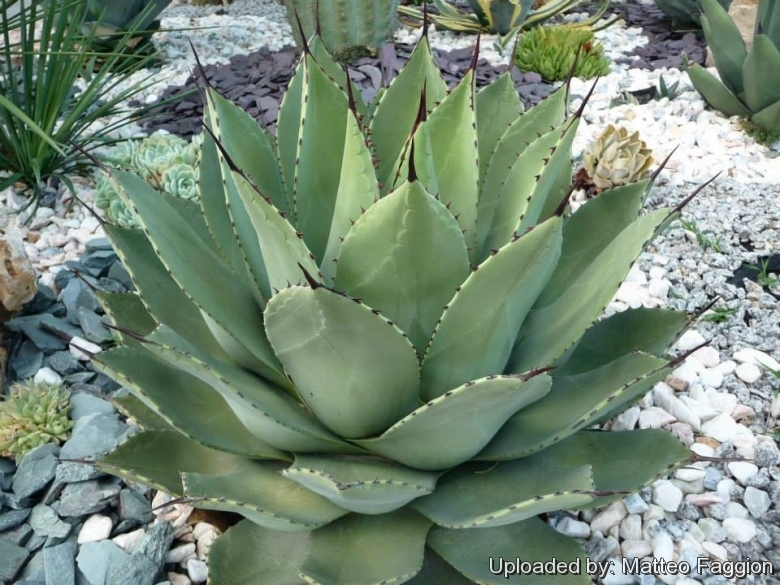
Agave applanata var. huachucensis (Agave parryi var. huachucensis) Photo by: Matteo Faggion
Origin and Habitat: Huachuca Mountains, Arizona on the Mexican border as far south of south as the sierra Huachinera. The populations in adjacent northeastern Chihuahua are probably to be assigned here too.
Altitude range: 1550-2480 metres above sea level.
Habitat and ecology: Agave parryi var. huachucensisSN|244]]SN|244]] dwells principally in oak woodlands on open slopes, but also in higher pine forest zones.
Synonyms:
See all synonyms of Agave parryi
back
Accepted name in llifle Database:Agave parryi Engelm.Trans. Acad. Sci. St. Louis iii. (1875) 311.Synonymy: 13
Accepted name in llifle Database:Agave parryi var. couesii (Engelm. ex Trel.) Kearney & PeeblesJ. Wash. Acad. Sci. 29: 474. 1939Synonymy: 3
Accepted name in llifle Database:Agave parryi var. huachucensis (Baker) Little in L.D.BensonAmer. J. Bot. 30: 235. 1943Synonymy: 3
Accepted name in llifle Database:Agave parryi subs. neomexicana (Wooton & Standl.) B.UllrichSida 15(2): 259. 1992Synonymy: 3
Accepted name in llifle Database:Agave parryi var. truncata GentryAgaves Cont. N. Amer. 543 1982.Synonymy: 2
Cultivars
(1):
back
Common Names include:
ENGLISH: Parry's agave, Parry's century plant, Artichoke Agave, Parry's huachuca agave, Huachuca Agave
ASTURIAN (Asturianu): Huachuca Agave
SPANISH (Español): Maguey, Penca, Mezcal, Agave Huachuca, ágave
Description: Agave parryi var. huachucensisSN|247]]SN|244]] (firstly described as Agave huachucensisSN|247]]SN|245]] by Baker in 1888) is an upland variant with larger growth of the widespread and variable Agave parryiSN|247]]SN|247]]. It is a compact freely-suckering rosette-forming succulent with broad short grey leaves with prominent brown terminal spines. It is more robust than the standard Agave parryiSN|247]]SN|247]], with larger leaves up to 20 cm wide and up to 65 cm long, and the flower stem broader with larger flowers up to 75 mm long.
Rosettes: Of densely arranged leaves, 45-60(-75) cm tall by 75-90 cm wide with the sucker growth producing dense clumps; dies after blooming.
Leaves: Grey-green with toothed margins and large sharp spine on tip; 25-65 cm long, 10-20 (or more) cm wide; point on tip is darker, can be tan, brown or black; leaf narrows at base, indentation of previously leaf shows on back of leaves.
Inflorescences: Large stalk held as high as 3-4.5(-6) m above foliage, branched;
Flowers: Bud pink opening to lemon yellow flowers tinged with pink, larger, 62-81 mm wide. Ovary 34 - 47 mm wide; Tepals tube 8 - 9 mm in diameter.
Blooming season: Flowering usually occurs in late spring or early summer.
Note: There is considerable confusion with Agave parryiSN|247]]SN|247]]i and Agave parryiSN|247]]SN|247]]i var. huachucensis - this plant has a tight rosette of broad short leaves - like the blunter leaf tipped Agave parryiSN|245]]SN|247]]i var. truncata it looks a bit like an artichoke. Some consider var. huachucensis as perhaps not worthy of even varietal status (and they may be correct), but it has long been grown as Agave parryiSN|244]]SN|247]]i var. huachucensis and it still has a value for a collector because they identify plants with particular characters.
Subspecies, varieties, forms and cultivars of plants belonging to the Agave parry group
Agave parryi is widespread over a vast territory giving rise to a corresponding amount of variability. This variability has been recognized by botanists and the current thinking by agave taxonomists is that Agave parryi consists of two subspecies: Agave parryi ssp. neomexicana and A. parryi ssp. parryi. The ssp. parryi is further divided into four varieties; the nominate form, var. couesii, var. huachucensis and var. truncata. The distinctions between the varieties are somewhat ambiguous and, although the varieties are weakly differentiated, it appears that there is some geographic separation between them.
 Agave parryi Engelm.: (subsp. parryi var. parryi) Rosettes globose compactly imbricate, leaves broadly oblong, one-third to two-fifths as wide as long, 10 to 15 cm broad, 30 to 40 cm long, scape 4–6 m tall; perianth tube 6–12 mm, limb lobes 4–6(–7) mm wide; capsules 35-50 mm broad. Distribution: Central and southeastern Arizona.
Agave parryi Engelm.: (subsp. parryi var. parryi) Rosettes globose compactly imbricate, leaves broadly oblong, one-third to two-fifths as wide as long, 10 to 15 cm broad, 30 to 40 cm long, scape 4–6 m tall; perianth tube 6–12 mm, limb lobes 4–6(–7) mm wide; capsules 35-50 mm broad. Distribution: Central and southeastern Arizona. Agave parryi var. couesii (Engelm. ex Trel.) Kearney & Peebles: it is a somewhat smaller plant with leaves less closely imbricate and smaller flowers 25 to 50 mm long. Distribution: Yavapai and Gila Counties from the north-western border of the species' range.
Agave parryi var. couesii (Engelm. ex Trel.) Kearney & Peebles: it is a somewhat smaller plant with leaves less closely imbricate and smaller flowers 25 to 50 mm long. Distribution: Yavapai and Gila Counties from the north-western border of the species' range. Agave parryi var. huachucensis (Baker) Little in L.D.Benson: is more robust, the leaves larger up to 35 cm wide and up to 65 cm long, and the panicle broader with larger flowers up to 75 mm long. Distribution: endemic of the Huachuca Mountains.
Agave parryi var. huachucensis (Baker) Little in L.D.Benson: is more robust, the leaves larger up to 35 cm wide and up to 65 cm long, and the panicle broader with larger flowers up to 75 mm long. Distribution: endemic of the Huachuca Mountains. Agave parryi subs. neomexicana (Wooton & Standl.) B.Ullrich: has leaves that "tend to be some-what more narrow, rosettes flat-topped, scape shorter, 3–4,5 m tall with fewer branches. Distribution: New mexico.
Agave parryi subs. neomexicana (Wooton & Standl.) B.Ullrich: has leaves that "tend to be some-what more narrow, rosettes flat-topped, scape shorter, 3–4,5 m tall with fewer branches. Distribution: New mexico. Agave parryi var. truncata Gentry: it is distinguished by its very small leaves with acute to truncate apex, shorter marginal spines and doesn't sucker much if at all.
Agave parryi var. truncata Gentry: it is distinguished by its very small leaves with acute to truncate apex, shorter marginal spines and doesn't sucker much if at all. Agave parryi cv. Ruby: The leaves in full sun take a nice purple tinge (hence the name).
Agave parryi cv. Ruby: The leaves in full sun take a nice purple tinge (hence the name).
Bibliography: Major references and further lectures
1) Urs Eggli “Illustrated Handbook of Succulent Plants: Monocotyledons” Springer Science & Business Media, 17 July 2001
2) Howard Scott Gentry “Agaves of Continental North America” University of Arizona Press, 01 February 2004
3) San Marcos Growers contributors “Agave parryi var. huachucensis (Artichoke Agave)” San Marcos Growers <http://www.smgrowers.com/products/plants/plantdisplay.asp?plant_id=2838>. Web. 07 June 2016.
4) Master Gardeners of the University of Arizona Pima County Cooperative Extension. “Agave parryi huachucensis - Parry's agave” first created September 10, 2001 and last modified May 15, 2004. Arizona Board of Regents <https://ag.arizona.edu/pima/gardening/aridplants/Agave_parryi_huachucensis.html>. Web. 07 June 2016.
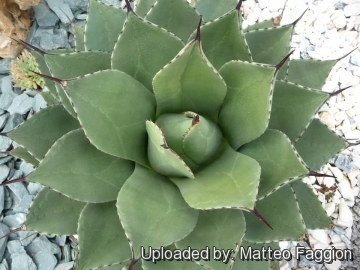 Agave applanata var. huachucensis (Agave parryi var. huachucensis) Photo by: Matteo Faggion
Agave applanata var. huachucensis (Agave parryi var. huachucensis) Photo by: Matteo Faggion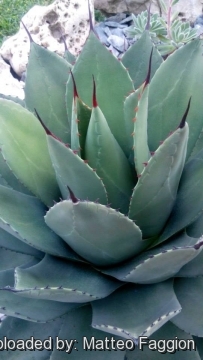 Agave applanata var. huachucensis (Agave parryi var. huachucensis) Photo by: Matteo Faggion
Agave applanata var. huachucensis (Agave parryi var. huachucensis) Photo by: Matteo Faggion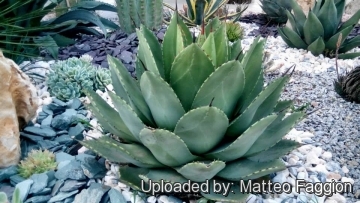 Agave applanata var. huachucensis (Agave parryi var. huachucensis) Photo by: Matteo Faggion
Agave applanata var. huachucensis (Agave parryi var. huachucensis) Photo by: Matteo Faggion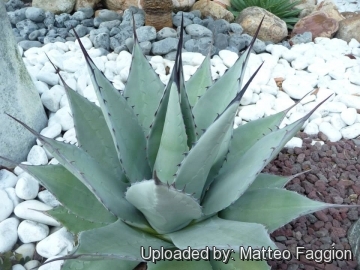 Agave applanata var. huachucensis (Agave parryi var. huachucensis) Photo by: Matteo Faggion
Agave applanata var. huachucensis (Agave parryi var. huachucensis) Photo by: Matteo FaggionCultivation and Propagation: Agave parryi var. huachucensisSN|247]]SN|244]] is usually cultivated outdoors in rock gardens, in cactus and succulent gardens, as it is very cold hardy, withstanding temperatures as low as -20° degree Celsius. It suckers, but tends to be slow to sucker, so easy to keep control of. Because of its compact size, plus its low water use and low maintenance, it is considered a good landscaping plant for desert residential landscaping.
Growth rate: Slow to medium growing, but speeds up considerably given the best conditions.
Exposure: They do well in full sun or a lightly shaded area with afternoon shade.
Soil: They are adaptable, but do best in very well-drained, sandy or gravely soil. As an ornamental it is also grown in containers where it stays smaller than its outdoor brethren. In pots they need a very porous mix soil (e.g. 2 parts peat moss to 1 part loam to 1 part of pumice).
Repotting: Use pot with good drainage.
Fertilization: They grows quickly if kept well nourished with a slow release fertilizer specifically formulated for cactus and succulents applied once or twice a year (poor in nitrogen), including all micro nutrients and trace elements.
Hardiness: Agave parryiSN|244]]SN|247]] is one of the most cold hardy of the agaves, (hardy to -18 to -28°C depending by clones (USDA zones: 5-11).
Scenography: These striking plants are wonderful when used for accent or simply to provide some all year round foliage and often used in a pot as a patio plant, can be moved around to change the scenery or position to give more shelter.
Maintenance: Minimal, removal of plant stalk and dead parent plant after blooming.
Traditional uses: This plant was called Mescal in association with the Mescalero tribe of the Native American Apache who roasted and ate the plant.
Warning: The spines along the sides of the leaves are retrorsely barbed, each barb arching backward; should one become embedded in the flesh of your finger, it would not come out easily.
Propagation: Seeds (easy) or suckers which often are found growing around the base of the plant. Remove the basal suckers (if available) in spring or summer and let the cuttings dry for a few days before inserting in compost.















